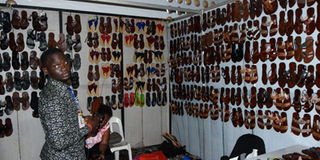8 takeaways from the Trade Fair

An exhibitor attends to a customer at the Trade Fair. Photo by Stephen Otage
There is no doubt that Uganda International Trade Fair (UGITF) organised annually by Uganda Manufacturers Association (UMA) is a popular calendar fixture.
Why? It is the only calendar event where businesses seek to grow their footprints in the market. In most cases, exhibitors showcase new products and technologies. And show-goers normally have their wish as they are more often than not treated to discounted prices.
This year’s show was well-choreographed with a view to optimize it to the maximum.
And here are the eight things we learned from the just-concluded trade fair.
What’s new?
A range of new products and innovations were exhibited such as locally made electric motor bikes, interesting maize threshers, some appealing medical diagnostic tools, interesting rechargeable batteries, unique agricultural inputs and amazing building materials, not to mention a variety of locally made crafts and garments.
Others are Ugandan made transformers, unique plastic chairs, high quality mattresses, new irrigation systems, new yoghurt flavours, new soft drink flavours, new water treatment technology, Trucks (Automobile), new and efficient chicken feed and technology and New flour machinery among other things.
BUBU
With the vibrancy of the Trade, Industry and Cooperative minister, Ms Amelia Kyambadde, Build Uganda, Buy Uganda (BUBU), is here to stay. Again, she demonstrated why this policy will be the game changer because with its continued enforcement, the contribution of manufacturing to the economy can only get better.
Executive wrath
Public servants and officials need to do more, according to President Yoweri Museveni. He does not like the fact that manufacturers are not audited in good time; that they do not get back their tax refunds, locking up their substantial capital. So, he gave the tax collectors and public officials a stern warning over this.
Business-to-business
This time round, business-to-business also referred to in the business circles as B2B, was taken more seriously than ever. Normally, such calendar events tend to degenerate into a market place rather than an exhibition arena.
From our vantage point, there was some balance this time. Senseless noise blasting away from littered public address systems was limited. Loud music was only allowed in the evening. Hope the Small and Medium Enterprises (SMEs) endorsed serious deals with suitable partners in the region or beyond.
Same old…
Issues of cost of power, high cost of credit and uncoordinated infrastructure (transport system), resulting in high cost of doing business in the country still persist. President Museveni said all these issues are being dealt with and soon, they will be history.
Attendance
Slightly more than 200,000 people thronged the trade show. About 500 exhibitors showcased their products and innovation. Of the 500 exhibitors, more than 25 came from Africa, Europe, and Asia.
Exhibitors were treated to dedicated sessions where they talked to each other to develop partnerships that should transform into a concrete future business deals. Worth noting is that opportunity aimed at creating markets for exhibitors in Uganda, as well as other regions was flung open.
This is because for the last 26 years, the trade fair has given a platform to both local and international exhibitors to showcase their products. The public awareness of the exhibitors arising out of their participation has resulted in the growth of numerous brands and companies that started off as startups in the trade fair and now enjoy international brand recognition.
Employment
“Promoting Job creation through Industrialisation” was the chosen theme. This comes at a time when the country is in urgent need to address the unemployment rates being faced. The theme is also intended to highlight the significance of manufacturing in creating employment opportunities to ensure a sustainable and inclusive growth path for Uganda to the realisation of the 2040 vision.
Good, bad news
According to the chairman of Spear Motors Ltd, Gordon Wavamuno, the trade show is on the right trajectory. The fact that it is still largely entertaining the growing number of local SMEs is a testimony of how far the trade fair has advanced over the years.
But this shouldn’t be allowed to evaporate, considering that it is the reason why the exhibition was started—to showcase the domestically manufactured products and innovation.
Makerere University School of Economics lecturer, Dr Fred Muhumuza couldn’t agree more. He said the trade fair is still important and its relevance cannot be underestimated. However the biggest problem at the moment is dealing with what he described as aggregate demand. He said the purchasing power of goods and services is so low and that is what needs to be addressed so that the products made by local manufacturers can be cleared from the shelves.




